Minnesota Streetcar Museum News Update
The 2006 operating season for the
Minnesota Streetcar Museum has
begun and is off to a fine start. We have enjoyed several major
accomplishments so far during the season and this exclusive to RyPN update on
our Museum highlights two of them.
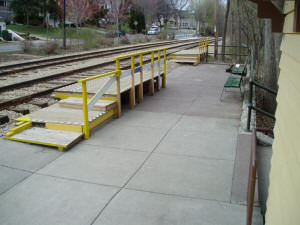 | |
When we resumed service on our Como-Harriet line after being out of
service for almost 90 days we used these temporary “high” platforms,
which were used for the remainder of the 2005 operating season. While
sturdy, they were rather small and created operational and safety
problems for us. It was clear that something better was needed. All
photos by John Prestholdt except as noted. |
New Platform at the Linden Hills Station is completed
The newly rebuilt track in front of our Linden Hills-Lake Harriet
station, caused by the TEA-21 track rebuilding project completed in late
summer of 2005 (see next item), resulted in the track directly in front
of the station being substantially higher than it was previously. This
caused an immediate problem in passenger loading and off-loading. So, in
August 2005 we built small and temporary “high level” platforms to load
and unload passengers. But it was clear that this was strictly a
temporary solution—a better platform was a must. Over the winter the new
platform was designed by Museum member, Ken Albrecht who also procured
the wood at a very reasonable cost and then supervised its construction
starting in mid-April. Many thanks to Ken for his work in getting the
platform finished. Our shop and physical plant volunteers really came
together to build the new and more substantial passenger platform which
was ready for the 2006 season’s opening day on May 6th. At times work
crews numbered upwards of 12 volunteers. The accompanying photos tell
more of the story of the new platform.
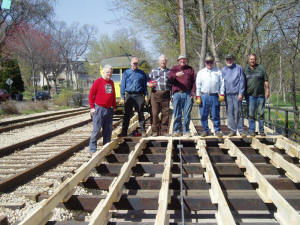 | |
Ken Albrecht drew-up plans for a more substantial platform that required
a considerable amount of wood. Luckily Ken obtained the equivalent of
scrap lumber at a greatly reduced price. The problem was that no piece
of wood was over four feet in length, so Ken designed the platform with
this limitation in mind. As shown in this mid-April photo, the
foundation is standard railroad ties with the stringers or floor joists
screwed to the ties. The crew this day consisted of (from left to right)
Neil Howes, Bill Arends, Dick Stoner, Ken Albrecht, Roy Harvey, Phil
Settergren, Jim Willmore and (not shown) photographer John Prestholdt. |
 | |
Teamwork is what made the platform project happen. Besides the people
shown in the foreground, several others are in the background working on
other areas of the platform. |
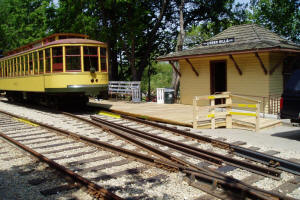 | |
Ken Albrecht doesn’t do anything that’s not first class, and the new
platform clearly shows that. The safety railings on the south end of the
platform were necessary because of the unevenness of the original
concrete platform underneath. Duluth Street Railway No. 265 (TCRT
Snelling Shops, 1915) is awaiting another load of passengers. The small
station was built in 1990 and is a replica of the one that sat on this
same site from 1900 until 1914. |
TEA-21 Track rebuilding Project is officially completed
On May 20th a special celebration was held to signify the completion of
the track rebuilding project at the Como-Harriet Streetcar Line. Close
to 75 Museum members and donors attended the ceremony held on a cloudy
day marked with occasional light rain sprinkles. While most of the track
work was completed in late summer of 2005 there still was work to be
done to restore the two historic streetcar stops. We felt, therefore,
that a formal completion ceremony should be scheduled in the late spring
when all facets of the project were completed. We also wanted to give
formal recognition to all those who supported the project, including all
the donors who contributed towards the project’s capital fund, called
the Campaign for Como-Harriet. The Campaign for Como-Harriet was
considered by most local observers to be the largest capital fund
raising campaign (raising over $170,000) and physical plant improvement
project in the 35-year history of the Como-Harriet Streetcar Line.
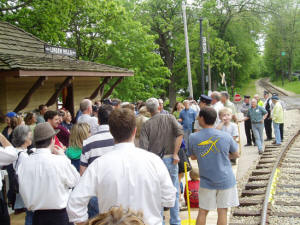 | |
Close to 75 people were present for the ceremony. Most of the attendees
were major donors to the fund raising Campaign for Como-Harriet and
Museum members. |
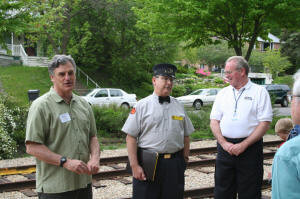 | |
A short thank you speech to the donors and other project supporters was
made by Jim Vaitkunas (middle). On the left, Hennepin County
Commissioner Peter McLaughlin is saying a few kind words. On the right
is Jon Gurban, Minneapolis Parks Superintendent, who also had some
complimentary words about the project and our Museum. Photos above &
below by Chris Heck.
|
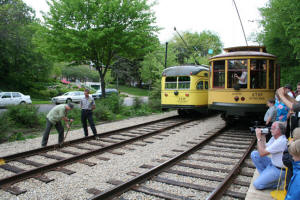 | | This photo shows Commissioner Peter McLaughlin tightening down the
ceremonial “golden bolt” signifying the official completion of the
project. Museum Chief Engineer, Keith Anderson, is to the right of
Peter. After the bolt was tightened, all attendees boarded Duluth Street
Railway No. 265 (right) and TCRT PCC No. 322 for a ride on the smooth
track. |
Presiding at the ceremony was MSM Board Chair, Jim Vaitkunas. We also
were fortunate to have two distinguished visitors at the ceremony. Peter
McLaughlin, Hennepin County Commissioner and Chair of the Hennepin
County Regional Railroad Authority, spoke about the importance of the
Como-Harriet line to the community. The Hennepin County Regional RR
Authority’s cooperation was essential as it agreed to be the sponsor of
the TEA-21 track project. (Hennepin County encompasses the area that
includes the city of Minneapolis and the western suburbs.) Jon Gurban,
Superintendent of the Minneapolis Park and Recreation Board, and who
lives within 100 feet of our railway, also spoke to the attendees. A
ceremonial gold-plated track bolt was tightened to signify official
completion of the project with Commissioner McLaughlin doing the honors.
(Jim Vaitkunas)
|






